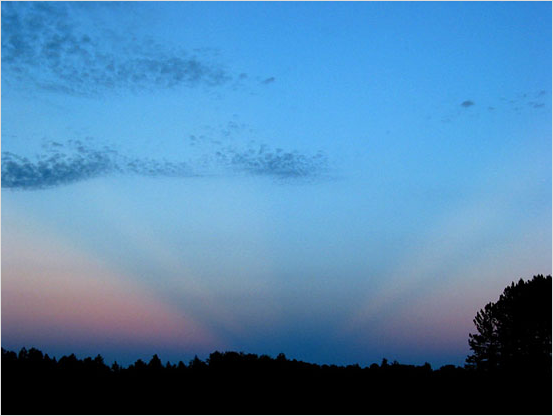Anti-crepuscular rays
Exploring the Enigmatic Phenomenon of Anti-Crepuscular Rays
Have you ever witnessed a breathtaking natural spectacle that left you in awe? One such phenomenon that often captivates observers is the occurrence of anti-crepuscular rays. These mesmerizing beams of light seem to converge at a point opposite the setting or rising sun, creating a surreal display in the sky. In this article, we will delve into the intriguing world of anti-crepuscular rays, uncovering their formation, characteristics, and the factors that contribute to their appearance.
Understanding the Nature of Anti-Crepuscular Rays
Anti-crepuscular rays, also known as antisolar rays, are a remarkable atmospheric optical phenomenon that occurs when sunlight is scattered by dust or water droplets in the atmosphere. Unlike their more well-known counterpart, crepuscular rays, which radiate from the direction of the sun, anti-crepuscular rays appear to converge towards the point opposite the sun's position. This convergence creates an illusion of parallel beams stretching across the sky, seemingly converging at a vanishing point.
The Science Behind Anti-Crepuscular Rays
The formation of anti-crepuscular rays can be attributed to the interplay of light and atmospheric conditions. When sunlight passes through a cloud or other atmospheric particles, it undergoes scattering. This scattering causes the light to change direction, resulting in the formation of rays that appear to diverge from or converge towards a specific point in the sky.
To visualize this phenomenon, imagine standing on a beach during sunset. As the sun dips below the horizon, it casts its light upwards into the atmosphere. If there are particles present, such as dust or water droplets, these scatter the sunlight and create visible beams. Due to the perspective from which we observe these rays, they appear to converge at a point opposite the sun's position.
Factors Influencing the Appearance of Anti-Crepuscular Rays
Several factors contribute to the formation and visibility of anti-crepuscular rays. Here are a few key elements that play a role in this atmospheric spectacle:
-
Atmospheric Particles: The presence of dust, water droplets, or other airborne particles is crucial for the scattering of sunlight and the subsequent formation of anti-crepuscular rays.
-
Angle of Observation: The angle from which an observer views the rays affects their perception. The convergence point of anti-crepuscular rays will vary depending on the observer's location and the angle at which they view the phenomenon.
-
Atmospheric Conditions: Weather conditions, such as the presence of clouds or haze, can enhance or obscure the visibility of anti-crepuscular rays. Clear skies provide a better backdrop for these rays to stand out against.
-
Time of Day: Anti-crepuscular rays are most commonly observed during twilight, shortly after sunset or before sunrise when the sun is low on the horizon. The low angle of the sun's rays enhances the visibility of these converging beams.
Chasing Anti-Crepuscular Rays
Capturing the beauty of anti-crepuscular rays on camera can be a challenging yet rewarding endeavor. Photographers often venture into serene locations during twilight to capture this ethereal phenomenon. However, it's important to note that the appearance and visibility of anti-crepuscular rays can vary from one location to another and from day to day, depending on the atmospheric conditions.
When attempting to photograph anti-crepuscular rays, it is advisable to find a vantage point that provides an unobstructed view of the horizon opposite the sun's position. This will allow for a clearer observation and better capture of the converging rays. Patience is key, as these phenomena may only last for a short period before fading away.
Appreciating the Wonders of Nature
Anti-crepuscular rays offer us a glimpse into the intricate workings of our atmosphere and the interplay between light and particles suspended within it. Witnessing these converging beams is a reminder of the vastness and complexity of the natural world. The ethereal beauty they bring to the sky serves as a testament to the wonders that can be found in the most unexpected places.
Next time you find yourself outside during twilight, take a moment to gaze at the sky and see if you can spot these elusive anti-crepuscular rays. Their appearance may be fleeting, but their impact on those fortunate enough to witness them will last a lifetime.

Anticrepuscular rays and shadows near Ashland, Wisconsin.
Taken 11 minutes after sunset, the rays appear to converge on the antisolar point already 2º high but behind the trees. The dark horizontal band is the shadow cast by the Earth onto the atmosphere. The band rises as twilight advances. Peg Zenko ( Tangent Photos ) took this image on 7th June 2003. "I was pretty excited over this one, enough to venture out into a swampy area at dusk. In Wisconsin that makes one a mosquito buffet."
Photo ©2003 Peg Zenko, shown with permission.
Note: this article has been automatically converted from the old site and may not appear as intended. You can find the original article here.
Reference Atmospheric Optics
If you use any of the definitions, information, or data presented on Atmospheric Optics, please copy the link or reference below to properly credit us as the reference source. Thank you!
-
<a href="https://atoptics.co.uk/blog/anti-crepuscular-rays-6/">Anti-crepuscular rays</a>
-
"Anti-crepuscular rays". Atmospheric Optics. Accessed on December 4, 2024. https://atoptics.co.uk/blog/anti-crepuscular-rays-6/.
-
"Anti-crepuscular rays". Atmospheric Optics, https://atoptics.co.uk/blog/anti-crepuscular-rays-6/. Accessed 4 December, 2024
-
Anti-crepuscular rays. Atmospheric Optics. Retrieved from https://atoptics.co.uk/blog/anti-crepuscular-rays-6/.